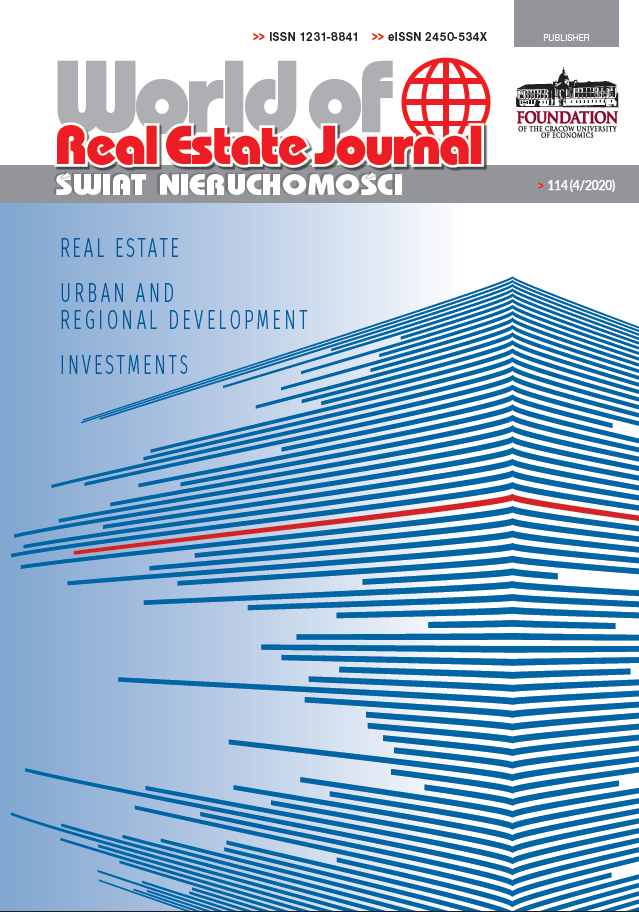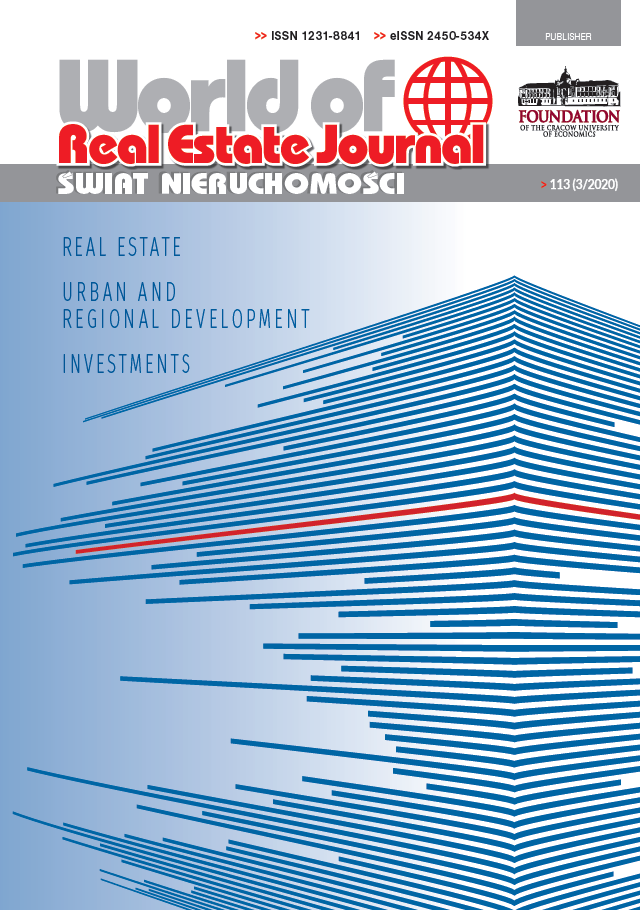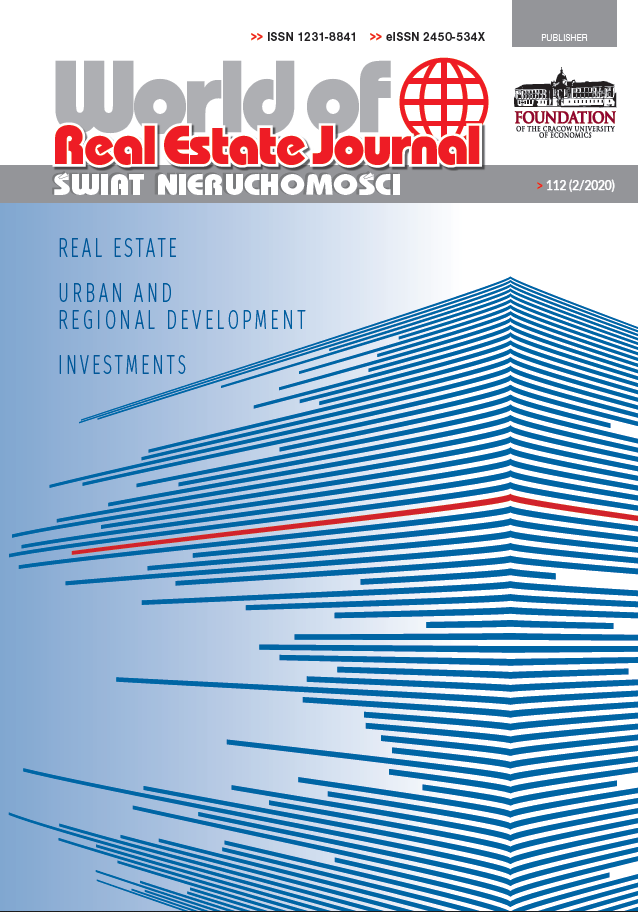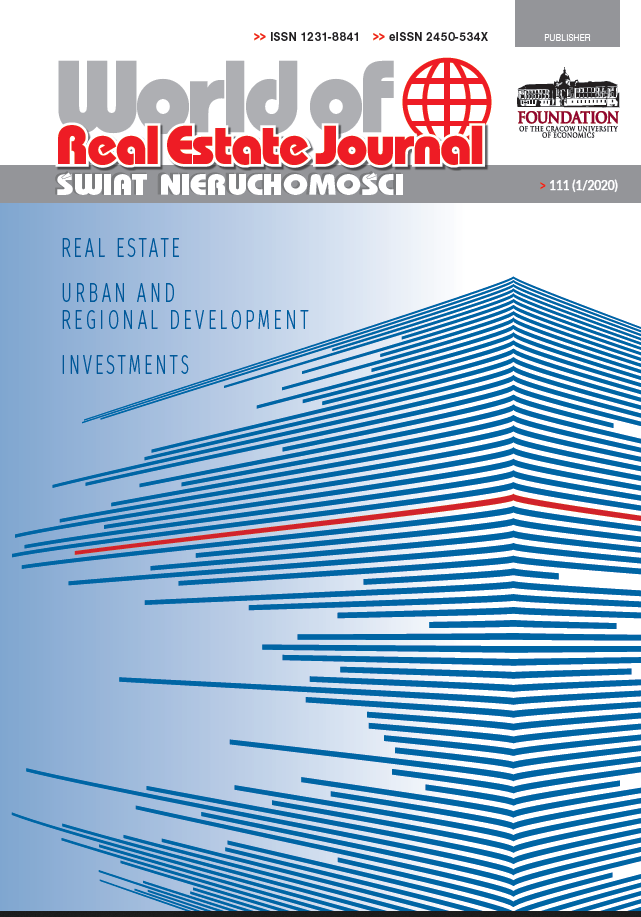MARKET
1. Leszek Kałkowski, Maciej W. Wierzchowski - 25 Years of Free Real Estate Market in Poland. A SWOT Analysis
2. Alina Źróbek-Różańska - A Decision Making Process on the Real Estate Market – the Case of Buying a Residential Plot for Building own House
REAL ESTATE MANAGEMEMENT
3. Anna Trembecka - Additional Annual Fees as a Consequence of a Failure to Develop Real Estate Let into Perpetual Usufruct
wużytkowanie wieczyste
4. Tomasz Noszczyk, Dawid Chaba - Rational Management of the Poviat Property Resource on the Example of Kielce Poviat
REVITALIZATION
5. Iryna Manczak - The Development of a Monument Town House into a Gastronomy Business
INWESTMENTS
6. Agnieszka Telega, Małgorzata Zięba - The Development of a Monument Town House into a Gastronomy Business
7. Eryk Głodziński - External Environment Conditions of Construction Companies and Adaptation Actions Taken by General Contractors
PROBLEMS OF URBAN DEVELOPMENT
8. Anna Jancz - Suburbanisation and the Housing Situation in the Poznań Agglomeration
HOUSUNG
9. Maurycy Michalski - Housing Policy at the Municipal Level – The English Experience
CHANGES IN REAL ESTATE LAW
10. Maciej J. Nowak - Revitalization Act DOWNLOAD
CONFERENCES
11. Joanna Bilska, Anna Czech - IV Students Scientific Conference of GRUNT Scientific Group „Housing Market: yesterday - today - tomarrow" (Kraków, 17-18 November 2015) DOWNLOAD
IN PUBLISHING MARKET
12. Ewa Kucharska-Stasiak „Ekonomiczny wymiar nieruchomości” – PWN publishing proposal DOWNLOAD
SUMMARIES
Leszek Kałkowski, Maciej W. Wierzchowski - 25 Years of Free Real Estate Market in Poland. A SWOT Analysis
The aim of this article is a synthetic presentation of the results of the assessment of the current state of the Polish real estate market, achieved after twenty-five years of its functioning in the conditions of market economy. The assessment was based on the SWOT analysis method in which supplementally, for the quantification of individual factors characterising the market, the method of Geneva (indicator method) was used. It was estimated that in 2014 the sum of:
• positive characteristics reached a total of 175 points compared to 200 possible (the Polish real estate market does not use approximately 12.5% of the value associated mainly with stimulating demand and the activation of our market for foreign investors);
• negative characteristics reached a total of 105 points out of 200 possible (the Polish real estate market is facing the neutralisation of a half of imperfections, resulting mainly from the poor economic condition of households, poor land management in urban areas).
Keywords: economic transformation changes in real estate market, SWOT evaluation
JEL Classification: R30, R31, R33
Citation (APA): Kałkowski, L., Wierzchowski, M.W. (2016). 25 lat wolnego rynku nieruchomości. Analiza SWOT. Świat Nieruchomości, (1(95)), 5-10.
DOI: 10.14659/worej.2016.95.01
READ ALL...Alina Źróbek-Różańska - A Decision Making Process on the Real Estate Market – the Case of Buying a Residential Plot for Building own House
A real estate buyer can be both a professional investor, able to conduct an adequate analysis on its own or advised by a counsellor, which leads to the optimal choice, and an ‘ordinary’ person who achieves knowledge about the real estate market from easily accessible sources of information and thus makes a decision on the basis of the basic data or own associations. The aim of the article is to present an individual decision making process. It has been assumed that the buyer of a plot intended for building a residential house makes a decision according to the weighted additive rule, including the possibility of compensation. It leads not to the optimal choice, but the most satisfying one. As a result, even the real estate with the weak value of the most important feature can be selected if it is compensated by very high values of other features. Deliberations based on the relevant literature are illustrated by the example of a potential buyer searching for a residential plot neighbouring Olsztyn.
Keywords: decision making process, buyer of the residential plot, real estate market
JEL Classification: D03, R21
Citation (APA): Źróbek-Różańska, A. (2016). Proces decyzyjny na rynku nieruchomości na przykładzie zakupu działki pod budowę własnego domu. Świat Nieruchomości, (1(95)), 11-16.
DOI: 10.14659/worej.2016.95.02
READ ALL...Anna Trembecka - Additional Annual Fees as a Consequence of a Failure to Develop Real Estate Let into Perpetual Usufruct
Public property management includes, among others, the control of the manner in which the real estate let into perpetual usufruct was developed. Besides the provisions of the acts and the rules of social interaction, an agreement appears to be a significant element shaping the content of the right of perpetual usufruct. The consequence of a failure to develop real estate let into perpetual usufruct may be imposing additional annual fees. In practice, this issue raises numerous problems and controversies, and it is also subject to non-uniform decisions.
The research thesis of this article is that the current regulations regarding additional annual fees contained in the Real Estate Management Act are imprecise. The aim of the study is to analyse the problems relating to the imposition of additional annual fees. The analysis was carried out based on the results of the study of the process of imposing additional fees by the Municipality of Krakow in the years 2010-2014.
Keywords: perpetual usufruct, land development, additional annual fees
JEL Classification: R52
Citation (APA): Trembecka, A. (2016). Dodatkowe opłaty roczne jako konsekwencja niezagospodarowania nieruchomości oddanych w użytkowanie wieczyste. Świat Nieruchomości, (1(95)), 17-22.
DOI: 10.14659/worej.2016.95.03
READ ALL...Tomasz Noszczyk, Dawid Chaba - Rational Management of the Poviat Property Resource on the Example of Kielce Poviat
The main aim of this article is to present the legal and organisational aspects of the functioning and management of the property of Kielce poviat (poviat – the second tier administrative unit). In addition to an extensive review of the literature, the paper also presents an analysis of the method of owning and sharing the poviat real property and shows the distribution of the resources of Kielce poviat considering the current legal status of plots divided into municipalities. The authors of the article have also analysed the structure of income from assets owned by the poviat. The study covers the period from 2011 to 2014. In the paper the method of static analysis and the analysis of sources are used.
Keywords: public real estate, land management, property resources, real estate resource, Kielce poviat
JEL Classification: H70, R50
Citation (APA): Noszczyk, T., Chaba, D. (2016). Racjonalne gospodarowanie powiatowym zasobem nieruchomości na przykładzie powiatu kieleckiego. Świat Nieruchomości, (1(95)), 23-32.
DOI: 10.14659/worej.2016.95.04
READ ALL...Iryna Manczak - The Development of a Monument Town House into a Gastronomy Business
The development of historic monuments for the needs of a gastronomy business is an important area of theoretical considerations and exemplifies the trends occurring in the business practice. The article presents the chosen aspects determining the development process of a historic building for the needs of gastronomy. It describes the characteristics based on which the term town house can be defined. The author presents the selected factors to be considered when opening a restaurant. The main part of the article relates to the conditions which must be considered when developing a monument real estate into a gastronomy business.
Keywords: real estate development, monument, town house, gastronomy business
JEL Classification: R39, L83
Citation (APA): Manczak, I. (2016). Zagospodarowanie zabytkowej kamienicy na potrzeby działalności gastronomicznej. Świat Nieruchomości, (1(95)), 33-38.
DOI: 10.14659/worej.2016.95.05
READ ALL...Agnieszka Telega, Małgorzata Zięba - The Concept of the Model for the Selection of Sustainable Office Building Location
The paper presents the concept of the decision-making model facilitating the selection of location for an office building fulfilling the requirements of sustainable construction. The concept of responsible property investing was discussed on the basis of literature studies. Sustainable office buildings are one of the ways of its practical implementation and the location of a building is among the evaluation criteria in sustainable building multicriteria certification systems, so it can improve the rating of a building. The proposed decision model for the selection of location was elaborated on the basis of multicriteria decision analysis applied in the GIS environment. Analytical criteria applied in the model were compiled on the basis of the BREEAM certification system. When the required data and spatial information are applied to this model, it allows to prepare the map of optimal spatial decisions.
Keywords: sustainable real estate, office building location, responsible investing, multicriteria decision analysis, MCDA-GIS, spatial analysis
JEL Classification: R14, R30, R32, R33, R52, R58, R15
Citation (APA): Telega, A., Zięba, M. (2016). Koncepcja modelu wyboru lokalizacji zrównoważonej nieruchomości biurowej. Świat Nieruchomości, (1(95)), 39-44.
DOI: 10.14659/worej.2016.95.06
READ ALL...Eryk Głodziński - External Environment Conditions of Construction Companies and Adaptation Actions Taken by General Contractors
The main objectives of the paper are to study selected conditions of external environment for the functioning of construction companies operating in Poland and to present the examples of adaptation actions taken by general contractors in the years 2007-2014. The research shows that in Poland there is close correlation between the GDP growth and changes in the sale of construction and assembly production. The adaptation actions taken by general contractors resulted from macroeconomics changes in economy. The research subjects concentrate mainly on institutional and instrumental modifications.
Keywords: construction company, general contractor, adaptation
JEL Classification: L7, L2, E3
Citation (APA): Głodziński, E. (2016). Uwarunkowania otoczenia zewnętrznego przedsiębiorstw budowlanych a działania adaptacyjne podejmowane przez generalnych wykonawców. Świat Nieruchomości, (1(95)), 45-52.
DOI: 10.14659/worej.2016.95.07
READ ALL...Anna Jancz - Suburbanisation and the Housing Situation in the Poznań Agglomeration
The main purpose of this article is to identify spatial diversifying effects and prospects of suburbanisation in municipalities of the Poznań urbanised area. Current effects of suburbanisation and its possible development are limited to the sphere of the housing industry. The applied research methods are spatial typology and the description and analysis of the housing situation in the Poznań urbanised area. In the article, as an introduction, the definition of suburbanisation is presented and also its evolution, as well as the economic data which describe and show the Poznań agglomeration.
Keywords: suburbanisation, spatial typology, housing situation
JEL Classification: C10, R58
Citation (APA): Jancz, A. (2016). Suburbanizacja a sytuacja mieszkaniowa w aglomeracji poznańskiej. Świat Nieruchomości, (1(95)), 53-60.
DOI: 10.14659/worej.2016.95.08
READ ALL...Maurycy Michalski - Housing Policy at the Municipal Level – The English Experience
Municipal housing is highly capital-intensive and therefore the majority of local government units (LGUs) in Poland cannot afford to provide council housing fast enough to shorten the waiting lists. Strengthening and development of municipal or affordable rent housing sector is one of the key challenges that housing policy at the municipal level in Poland has to face. According to the author, an interesting solution in this respect is to incorporate public-private partnership into the toolkit for implementing housing policy. This solution has been used for a long time in England, where the burden of providing housing to low income households was passed from LGUs to private non-profit organisations.
Keywords: municipal housing, housing associations, local or regional government units, public spending, housing demand, government housing policy
JEL Classification: H72, H75, R21, R28, R31, R38
Citation (APA): Michalski, M. (2016). Polityka mieszkaniowa na szczeblu lokalnym – doświadczenia angielskie. Świat Nieruchomości, (1(95)), 61-67.
DOI: 10.14659/worej.2016.95.09
READ ALL...





















































